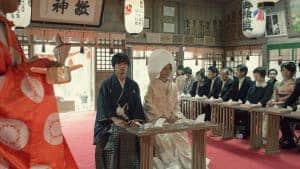
22 Traditional Wedding in Japan - Etiquette - Ceremony

But now let's take a deeper look inside the Shinto wedding as the traditional wedding in Japan. Here are some fun and unique facts that you need to know about traditional wedding in Japan.
Also read:
The Origin Shinto Wedding - Traditional Wedding in Japan
Shinto Wedding became a popular traditional wedding in Japan after the marriage between Prince Yoshihito and Princess Kujo Sadako. The marriage was held back at the Imperial Palace in 1900s. After that, the Japanese shrines started to hold similar ceremony in Tokyo. The wedding ceremony became more and more popular after being held in other cities like Osaka and Kyoto. Actually, the wedding ceremony had first started in early 1872. But then it was held without any preference to a certain religion. The purpose of the ceremony at the time was solely to protect the bride.
Also read:
- How to know people are lying
- Ways to know someone likes you secretly
- How to tell if your friend is lying
Contents
The Ceremony of Japanese Wedding
The traditional wedding ceremony was a typical small affair with only close family and relatives in attendance. While the wedding reception in open to a larger society. Here are steps in the traditional wedding in Japan.
Also read:
1. Shinzen kekkon
The traditional wedding ceremony was guided by a priest, and first of all is the Shinzen kekkon. It was a purification ritual in Shinto that incorporate the exchange of sake before married between bride and groom. Food items were left at the wedding altar as well as the wedding ring. The couples stood in the center of the room, while family members stand behind a table containing sake and fruits. The initial ceremony took 20 to 30 minutes to complete.
Also read:
- Signs of shy girl crush on you
- Signs she is not interested in you
- How to know when a girl is into you
2. San san ku do
After the completion of the purification, the priest then announced the beginning of the san san ku do, literally "three-three-nine-times". It reflected the three oaths taken three times, represented by three cups, poured three times, swallowed after three sips. The three cups usually had increasing size. First and smallest cup was poured to the groom, whom drink from it before offering to to the bride. Second and middle-sized cup was poured to the bride, then to the groom. While the last and largest pour was come to the groom then the bride (repeating the first cup).
Also read:
3. The vows
After drinking, the next step in the traditional wedding in Japan is the vow reading. The groom and bride would approach the altar. The groom then read his vows for three times while the bride listened.
Also read:
4. The Nakodo
Japan had a long history of a matchmaker or "Nakodo". The Nakodo usually set up the meeting between couples and they eventually get married. In the wedding ceremony, the bride and groom had their chance to thank their Nakodo in the vows. But if there was no Nakodo, the closest person to the couple would fill the place as best man or bridesmaid.
5. The final steps
In the final step of the ceremony, the priest offered Japanese evergreen to the altar as a reflection of gratitude to the spirits who blessed the couple. Bride and groom would follow with their own offering as well as the family representative from both sides (usually the fathers). After that, the wedding ring was presented.
Also read:
The Japanese Wedding Wardrobe
Traditional wedding wardrobe in Japan was quite fascinating. Most of the time, the wedding costumes was white, represents the country's flag which consist of big part of white with some red color.
- The bride's gown was made of delicate silk or other sleeky material. Wearing an evening gown in a wedding ceremony was quite common in Japan, even though this may come as a surprise to you.
- Bride was wearing a head piece, a white silk hood oven the bun in her hair. The silk headdress was called wataboshi, one of the oldest tradition in Japanese wedding. The hood was said to represents humility and modesty.
- Beside the silk hood, bride wore a paper hat called tsuno-kakushi or "horn hider". This hat was meant to conceal the jealous demons or the "horn" itself.
- The groom usually came in black color, and they could wear suits or kimonos (as it was a traditional ceremony, the suits were rarely worn).
Also read:
Wondering about your man? Let's find out who he really is.
From the newly dating to the happily married, trust issues can creep up on anyone. With cheating cases soaring over 40% in the last two decades, it's natural to have your doubts.
Could he be sending flirty texts to another woman? Or secretly swiping on Tinder? Or even have a hidden criminal past? Or, the worst fear - could he be cheating?
This useful tool can bring the truth to light. It'll dig out hidden social media accounts, dating profiles, photos, any legal run-ins, and more. Let us help clear your mind.
More unique facts of Japanese
- Japanese had their own marriage gods called Izanagi and Izanami. They were said to be invoked during the wedding prayers. The gods were called to reflect a harmonious balance in the marriage. The prayer also included some best wishes for the newlyweds, including for them to maintain a respectful home and having children.
- Before marriage, there was an engagement tradition named Yuino. It was a symbolic ceremony where two families exchanged symbolic gifts. The most popular gifts were a konbu (seaweed) that refers to "child-bearing woman"; a long piece of hemp symbolizing the wish for the couple to grow old together; and a folding fan that spread, symbolizing a good wealth.
- The guest attending the wedding ceremony should bring gift money (called the goshugi) as their blessing and gifts. The amount of money was decided by the giver. It was offered in a special envelope with gold and silver strings called the shugi-bukuro. While the other gifts should wrapped in an ornate rice paper.
- Close family and relatives should also gave the gift money, and they would give the twice amount given by the friends and other guests.
- According to the name, traditional wedding in Japan was held in the Shinto temples. The temples had some iconic religious feature which made it more attractive. The most common icons were the water pavilions, stone dogs, and the tall red gates symbolize the division between corporeal and spiritual worlds.
- Wedding speeches played an important role at the traditional wedding in Japan. The wedding attendance, including family, friends, and colleagues would stand in line and taking turns to give their blessing and best wishes for the newlyweds. The content of the speeches may vary, usually a moralistic tales about marriage or heartfelt message from the family and friends.
- Exchanging gifts were also a thing in the Japanese wedding. You would find the parents of the bride and groom showered with parents. The couples who were married was the one who provided all of those.
- The gifts for parents were meant to make the wedding more intimate and special for the family as well, as the most common gifts were a toast for them or a bouquet of flowers and also a personal letter contained with love and thanks from the children.
- Not only the parents and the married couple, the guests who attended the wedding would not left empty handed. There was a special gift presented by the bride and groom for every single guest at the wedding. It could be a lace bag, sweets, or another goods.
- Traditional wedding in Japan was changed a lot after the war. As it no longer a state religion, the number of the Shinto wedding decrease rapidly. The modern life started with the mass movement into cities and smaller houses, which make it more difficult to held such ceremonies.
- In the contemporary era, traditional wedding ceremony still attracted some Japanese. But instead of held inside a temple, the ceremony was moved into a large venue such as hall or hotel that decorated resembled a Shinto temple.
- From 1990s onward, the traditional wedding in Japan has shifted from Shinto wedding to a Christian wedding ceremony, regardless of the beliefs and religions of the married couple.
- Traditionally, there were two types of marriage in Japan based on how someone find their partner. First was omiai, a wedding resulted from an arranged introduction or the matchmaking. Second was ren'ai, a wedding where the bride and groom find each other and willing to married on their own.
Those are the unique facts about traditional wedding in Japan. Wedding customs were usually driven from the culture and religion of the society. The traditional wedding itself often reflect the beliefs of the ceremony holder, in the hope of a bright future and the marriage life to come would be full of wealth and blessings.
Also read:
- Dating culture in US
- Dating culture in England
- Dating culture in Turkey
- South african dating culture
- Dating culture in Sweden
- Dating culture in Germany
Utilize this instrument for a comprehensive background check
Whether your relationship is in its budding phase or you're in the blissful realm of marriage, escalating infidelity rates (over 40% in the past two decades) warrant your caution.
You may want to ascertain whether he is engaging in secretive text conversations with other women, maintaining active profiles on dating platforms like Tinder, or concealing a criminal history. Or you might be fearing the worst - infidelity.
This robust tool is designed to uncover hidden social media and dating profiles, unseen photographs, undisclosed criminal records, and much more, providing you with the clarity you need.











